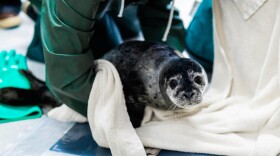A white raven has been turning heads around Kenai for the last month. Gregory Messimer, a local photographer, has been documenting the bird, and he says the white raven is both visually striking and culturally symbolic.
Messimer is an amateur photographer in Kenai, who has been photographing and keeping tabs on the bird for weeks.
He first saw it on June 16 in North Kenai, among a family of mostly black ravens.
“The parents in this group had seven chicks that made it, and one of its siblings has some white feathers on its chest, and one had reddish feathers on its neck and face,” Messimer said.
According to the Kenai National Wildlife Refuge, the raven probably isn’t albino, a condition involving an absence of certain enzymes that create melanin, and results in a complete lack of that pigment. Instead, it’s what’s called leucistic, which means there’s a lack of pigment in some feathers due to an absence of cells that produce melanin.
Messimer said he took note, not just because of the bird’s aesthetic differences, but because the white raven has symbolic relevance in many religious traditions and mythologies.
“It’s an omen, or it’s a curse, or it’s a blessing, but mainly it’s ‘some sort of change is about in the world,’” he said. “Whether it’s good or bad depends on the tradition.”
In Greek mythology, the white raven is associated with the god Apollo. In Haida tradition in northwest Canada, a white raven helped bring the sun, moon and stars to earth, but turned black when it brought fire to humans.
Messimer said “white raven” is also an idiom.
“In Europe, it turns out, a ‘white raven’ is a saying for something that has a very low chance or an impossibility,” he said.
The Kenai National Wildlife Refuge posted about the bird on Facebook as sightings trickled in, and called it, “truly a once in a lifetime occurrence.” The refuge confirmed that the bird is leucistic, not albino, because it has blue eyes, instead of red, which would indicate albinism.
Messimer is worried about the prospects for the bird. He said the white coat makes the raven vulnerable, because melanin provides structure to the feathers and skin. They’re also more susceptible to bacterial infections, and to sunburns and cancers. He suspects the bird is unlikely to survive the winter.
“The white feathers don’t allow it to hold in heat, or absorb heat, so they’re reflective in the winter,” he said.
His hope, he said, is that the bird may be taken in by the Alaska Wildlife Conservation Center near Girdwood, or the Alaska Raptor Center in Sitka. In the meantime, he’s keeping an eye out for the raven to snap more photos, and hoping this one is a good omen.





